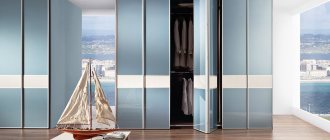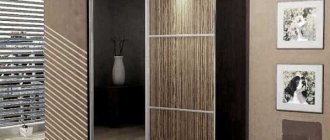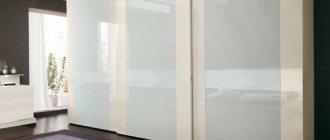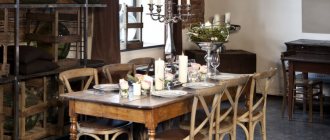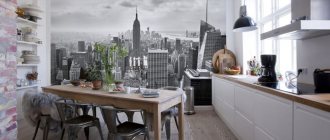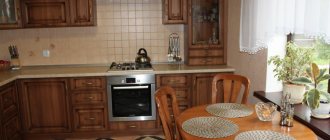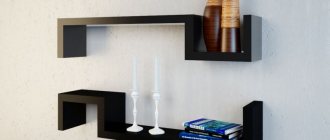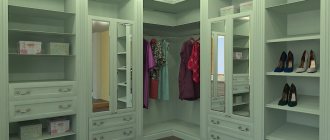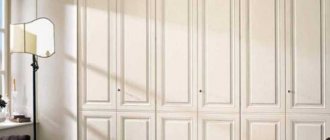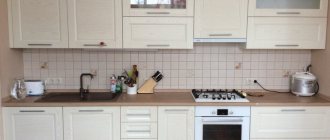Any transparent material - from fabrics to polycarbonate - has an indescribable charm. This is especially true for glass. Any structure, even massive and bulky, will seem weightless and elegant if made of glass.
It is not surprising that glass facades for the kitchen are so popular and varied. The decorative possibilities of this material are endless.
Glass for the kitchen: facades, panels, accessories
Ordinary silicate glass, of course, is not suitable for a kitchen set. Despite all its attractiveness, it is fragile, and if broken, it poses a considerable danger due to the abundance of fragments with sharp edges.
However, when making facades with your own hands and even in production, they often use it, believing that when glazing wall-mounted boxes, they are much less likely to be subjected to mechanical stress, and, therefore, the threat of breaking them is small.
Glass for kitchen facades can be as follows:
- Laminated - the process is usually used to make the material more decorative, but there are also special films to increase strength.
When making a headset with your own hands, it is highly advisable to cover the surface with such a film.
- Hardened – thanks to special temperature treatment it acquires high viscosity. It is so difficult to break that it is used for frameless cabinet fronts. And if you still manage to do this, then the material crumbles into fragments with rounded edges.
An additional advantage of the hardened version is resistance to temperature. A tempered glass apron can be installed next to a gas stove. It is possible to manufacture facades, glazing, tabletops, and handles.
- Triplex is laminated silicate glass glued with a polymer film. If damaged, the fragments remain glued to the film and do not fly apart. However, the likelihood of such an event in the kitchen is negligible: triplex does not always break even during a car accident.
- Acrylic glass is used much less frequently in the manufacture of kitchen furniture, as a rule, only for glazing wall cabinets. This is not due to strength, but to thermal instability. When exposed to high temperatures, acrylic material may become deformed. But for do-it-yourself glazing, this is the most beneficial option: it is easy to cut, decorate, and you can even make bent facades from it.
Interesting backlit option
In classic interiors
At first glance, this material does not quite suit classic interiors - they expect something more familiar.
However, judging by the reviews, a tempered glass facade looks good in this design style - the main thing is to choose the right colors. You can make transparent embossed doors. They look stylish and modern without disturbing the overall stylistic harmony. We advise you not to save money: if the glass elements are not strong enough, they can burst even under the influence of steam.
At the same time, glass does not have to be mirror or transparent: modern technologies allow it to be painted in any color. We recommend light beige - the elegant set fits perfectly into the design and seems very stylish.
Translucent elements go well with wood. Choose appliances that are similar in shade to create a cohesive look.
An interesting move: You can install a protective glass panel on the apron. This will protect the wallpaper from dirt.
Glass facades: varieties
Cabinets are manufactured in three main ways:
- Glazing is a traditional solution. A hole is cut in the sash and glass is inserted. Both regular and hardened are used. Glazing gives even the simplest façade lightness and visually expands the room, as cabinets with transparent inserts appear to be open structures like shelves.
Glass can be transparent, frosted, colored, consist of several fragments that form a pattern, relief, etc. The photo shows stained glass at the top of the set.
Frame façade – the insert is firmly fixed into the frame. It can be an aluminum profile, MDF frame or wood profile. Depending on the style, choose a narrow profile (minimalist styles), or a wide one, creating a kind of contrasting frame.
Making a kitchen facade under glass with your own hands is not an easy task. But anyone can insert a glass fragment into a framed MDF facade. The aluminum profile assumes a more durable factory fastening. The photo shows an aluminum profile in a glass facade.
Black kitchen with framed glass facades
- Frameless facade - made entirely of glass and only tempered glass. The production technology is quite complex, so you can’t make such a set with your own hands. The cost of a kitchen with a frameless glass facade is much higher.
Glass for kitchen facades: description and characteristics
To choose suitable glass facades for the kitchen, you need to know the main types of material, the advantages and disadvantages of each.
Types of glass for kitchen facades
Glass must be durable and practical; the appearance and service life of kitchen facades depends on this. The following varieties are distinguished :
- Thermopolished is the most affordable option. There are transparent and matte options, the material has a perfectly smooth surface. Disadvantages: fragility and weak immunity to external influences. Thermopolished glass quickly scratches and loses its attractive appearance.
- The laminated material is covered with a special film, which makes the material more durable and protects it from scratches. The film gives the glass a matte effect. This option is used only for kitchen sets with framed facades, otherwise the film will peel off at the edges. Light weight is also an advantage.
- Triplex is a material made of two thin glasses bonded with a special compound. Triplex is highly durable and difficult to break. The disadvantage is the high cost.
- Acrylic glass is an option for budget kitchens. The facades look stylish and original, but do not tolerate high temperatures and lose their attractiveness over time.
- Tempered glass (stalinite) is the most durable and practical option. Not subject to cracks and scratches, moisture and sudden temperature changes. Suitable for making frameless facades. If damaged, it breaks into rounded pieces and cannot be scratched. The downside is the high cost.
Framed glass facades are suitable for arranging small kitchens - they look weightless. The frame is made of metal and can be thin and inconspicuous or wide and bright - depending on the style of the interior.
Frame options are the most reliable and durable. Frameless glass facades look elegant, but are expensive.
Why do they use tempered glass, their manufacturing technologies
Tempered glass is used to produce high-quality and expensive kitchen sets . With proper care, such furniture will last more than 20 years.
The secret to the strength of the material lies in its manufacturing technology . A sheet of glass is heated in a special furnace to a temperature of +700°C, then sharply cooled with a stream of cold air. As a result of this jump, tension is created, which increases the strength of the material and resistance to sudden temperature changes. At the end of hardening, a film is formed on the surface, which protects the material from impacts and chips.
Attention! Tempered glass facades for the kitchen are glossy, matte, semi-matte, white on the cut, with decorative inserts. Not only kitchen facades are made from this material, but also shelves, countertops, wall panels and aprons.
How glass facades look in a small kitchen
This design option fits harmoniously into the smallest rooms . Choose transparent or translucent facades - they visually enlarge the kitchen. It is not recommended to use heavily decorated surfaces: give preference to smooth and even ones.
In a classic interior, glass is combined with a wooden kitchen set in wenge color, in a Provence kitchen - with furniture in white and beige shades. The facades are decorated with laconic handles.
Glass facades are used to complement modern small kitchens . For example, so that the loft style in gray or black colors does not visually make the kitchen smaller, transparent glass doors are used instead of solid doors. This rule also applies to minimalism and hi-tech styles. The material can be combined with any colors.
Types of glass decor for facades
Decorating facades is a convenient way to create a unique kitchen design and highlight its advantages.
It is recommended to think through the decor option and execution technique in advance.:
- Matte and tinted fronts in muted colors bring mystery and coziness to the kitchen. The shelves with kitchen utensils are not visible behind them, only the outlines of objects are visible. To make them, a special coloring pigment is added to the material: black, gray, beige, brown. It is wear-resistant, does not wash out with water and does not crack. Matte finish is appropriate in modern interiors - minimalism, loft, hi-tech.
- Transparent ones focus attention on the cleanliness and shine of the kitchen, emphasizing the taste of the owner. They harmonize with any colors and materials, fit into any interior.
- Engraved options are used to decorate kitchens in classic, modern, vintage, and contemporary styles. The type and pattern of engraving is chosen based on the style of the interior: flowers, fruits, geometric shapes and lines, wavy contours.
- Glass with photo printing looks bright and stylish. The drawing is selected to match the kitchen design. For example, for a Mediterranean-style interior it’s sea and sand, for a retro kitchen it’s a black and white photograph of the Eiffel Tower. Ceramic paints are applied to the glass surface, baked with UV rays and varnished. Such material cannot be scratched. Images with a 3D effect look unusual.
- Stained glass facades are an option for luxury, expensive kitchens. Multi-colored glass elements are fixed in a special frame. There are smooth and voluminous stained glass windows; with their help it is easy to create a unique kitchen design.
- The sandblasted decor combines transparent and matte elements. Sandblasting is used to create images and patterns of any complexity.
The combination of glass and metal in kitchen design
Metal and glass are integral elements of a high-tech kitchen design. They symbolize lightness and weightlessness and serve as a reference to the interiors of the future. The materials are environmentally friendly and practical, and have a long service life. The metal harmoniously frames the glass and protects it from moisture and dirt. Both matte and glossy options look impressive.
Attention! To emphasize the style and beauty of the kitchen, use glass decor on the walls - mirrors, paintings and photo frames; metal elements - table legs, candlesticks, clocks. Everything together creates a complete, complete picture in the room, where objects are harmoniously combined with each other.
Design of glass facades: simple techniques
It is easier to say how not to decorate glass than to list all the techniques that designers resort to. The material possibilities are truly endless.
- Transparent. The polished shiny surface is attractive in itself. Both curved and smooth facades are produced. Moreover, not only radius cabinets can be a product of unusual shape.
Handles, tabletops, and even a chair or table made entirely of glass can have any shape, reproducing, for example, characteristic carvings in the Baroque or Empire style. An equally popular option is when an aluminum profile is used for the furniture frame and the filling is made of glass.
- Colored . The dye is included in the original raw material, and therefore the material does not fade in the sun and does not change over time. Stained glass windows are assembled from the colored version, and it is also used for glazing. The catalog of each specialized manufacturing company, as a rule, includes at least a hundred shades.
Kitchen from with facades made of painted tempered glass
You can get it yourself if you cover the back surface with colored film. Being under glass, it is not damaged and fades significantly less.
- Radial kitchen fronts with frosted glass are especially impressive. For Provence, transparent colored ones are often used. But in high-tech and minimalism, lighting is often used when decorating facades, and frosted glass, illuminated from the inside, looks amazing. The photo shows frosted glazing of a high-tech kitchen.
Glass facades: how they are used in kitchen units, pros and cons
The advantage of the material is environmental friendliness and hygiene . Glass does not absorb dirt and moisture, which prevents the formation of mold and mildew. During operation, the material does not release toxic or hazardous substances into the air.
One of the advantages is the wear resistance of glass . It tolerates sudden temperature changes, heat and steam, and high humidity. Over time, such facades do not deform or fade from the sun, and retain their original shine and attractive appearance.
Glass harmoniously combines with any materials , be it expensive natural solid wood or budget plastic. With the help of different design options, it is easy to match the glass facade to any interior style.
Attention! Glass façades require a regular glass cleaner and a soft cloth to clean, but they require frequent cleaning. If you do not take care of the appearance of the surface, stains and stains will appear on it over time.
The downside of glass facades is fragility and weak immunity to shock. If handled carelessly, the glass will break, injuring a person. They also note the cost: high-quality glass facades are expensive.
Facade design: complex methods
Conventionally, methods that make it possible to obtain a single-color surface are classified as simple, and methods that make it possible to obtain a surface that is multicolored or consisting of different fragments are classified as complex. The division is approximate, since, for example, the same aluminum profile can be used to connect colored fragments into a stained glass composition.
Glass painting is the most affordable way to change the appearance of your kitchen with your own hands. Acrylic and stained glass paints give excellent results.
- Sandblasting - this way you get a matte pattern on a transparent background or vice versa. With just one combination of textures you can achieve amazing results. The photo shows sandblasted glass inserts.
- Stained glass is one of the most striking methods of decoration. Real stained glass windows, assembled from colored fragments fixed with a frame, appear quite rarely in the kitchen: the cost is very high. But a convincing imitation is quite accessible.
The basis of the decor is stained glass paints. To obtain an image, a drawing is transferred to the surface, the borders are outlined with a special composition - a gold or silver stained glass outline, and the areas are filled with paint. The photo shows stained glass windows on the facade of the kitchen.
Stained glass windows are in perfect harmony with the facades
- Photo printing . Glass has not escaped this fashion, especially since its smooth surface is ideal for transferring images. And since the design can be anything, photo printing is rightfully considered the easiest way to get the only kitchen set in the world. The catalog of any company, as a rule, offers at least a couple of hundred options. In addition, you always have your own photo archive at hand.
The techniques are not universal: if you can equally successfully make handles, tabletops, aprons, and curved facades from colored, frosted and transparent glass, then, of course, you can’t make handles from a material with a pattern. Sandblasting is equally effective on cabinet doors and on tabletops, but stained glass windows are acceptable only for facades.
Is there an advantage of glass facades over facades with glass inserts?
Glass facades combine attractive appearance and originality, practicality and environmental friendliness . There is no need to look for options where, in addition to glass, there is another material: wood, plastic, MDF or chipboard.
However, in each case everything is individual. In one kitchen only glass is appropriate, in another - plastic or wood with glass inserts .
The only advantage of the second option is that such facades are cheaper than all-glass ones.
Kitchen accessories
For modern styles, the use of glass is the most standard technique. It is difficult to imagine an interior in a techno or hi-tech style without transparent or matte inserts. So glass is widely used here.
- Handles (usually knobs) are simple round or, conversely, sculptural in shape, corresponding, for example, to the neo-baroque style. It's amazing how glass handles decorate even the simplest set. Any catalog of kitchen accessories must include handles.
- In a kitchen with glass, it’s even somehow inconvenient to use some other option for an apron, especially since tempered glass meets all the requirements: it is durable, moisture-resistant, tolerates temperature changes well, and is not afraid of hot fat or soot. Cleaning a glass kitchen apron is a pleasure – a couple of swipes with a sponge, and the surface is completely clean.
- The same can be said about the countertop. Moreover, if a glass dining table has already become quite common, then floor cabinets with such a tabletop are still a novelty. But it has the same advantages as glass wall panels, and, in addition, it is amazingly decorative. The photo below shows a tabletop with a pattern.
The tabletop can be inserted into the profile - rather to protect the glass than the household from scratches - or it can be sanded. The profile can also be used decorative.
For all its excellent qualities, glass has one drawback that is common to all products - a characteristic and loud sound upon contact. There is no such thing as a quiet glass kitchen.
How to properly care for kitchen glass facades
For cleaning, use glass cleaners and soft sponges . Hard metal sponges and detergents containing abrasives are not suitable, otherwise scratches will appear on the surface. Water stains and grease stains quickly appear on such facades, so it is recommended to wash the kitchen at least once a week.
In the kitchen
When choosing glass furniture for the kitchen, you should take into account the style.
Designers suggest decorating the work surface with colored tempered glass, and choosing a translucent dining table with wooden legs. If the chairs are plastic, then a glass tabletop should be installed on the same base. The original proposal is a glass apron, and behind it a TV screen.
Items in the kitchen get dirty more often, and grease settles on surfaces. Glass furniture is easy to care for and wash.
Advantages and disadvantages
A glass kitchen has a number of advantages compared to kitchens made from MDF and other solid materials.
- The ability to choose different designs of glass panels, which significantly change the appearance of the kitchen.
- The originality of the door material creates a feeling of more space even in a small kitchen.
- This is the best material from an environmental point of view; it is not affected by high temperatures and high humidity.
- The glass surface is quite easy to care for. For this purpose, today various means are offered that significantly simplify the process. Often, a bottle of special spray and a soft, dry cloth is enough.
Do not use abrasive products to care for the glass facade; this may scratch the surface. It will be difficult to remove such a scratch.
However, glass furniture has its drawbacks.
- A glass door will cost more than a similar one made from other materials. The price is affected by both the cost of the glass itself and the high cost of the fittings needed for normal installation.
- The need for constant care of the glass surface. In the kitchen, there is a lot of fat in the fumes that settle on the surface of the furniture. Dust settles on it and noticeable stains form. This is especially noticeable on glass.
- The aluminum edge of a frame design may darken over time. This is possible if aggressive cleaning agents are used during maintenance.
Glass has its advantages, but also disadvantages
Glass in the interior of individual rooms
Glass bathroom furniture is an ideal solution, especially if the room is prone to mold growth. Glass bathroom furniture is resistant to rust and fungi, and a special product or ammonia can deal with stains and drips on a capricious surface.
When making cabinet furniture, designers often combine glass and mirrors. The combination of glass showcases with a metal frame is popular. The glass cabinet in the living room today has again become a relevant piece of furniture, but it no longer looks like grandma’s sideboards, which only had glass doors. A modern display case with glass shelves is not only a place to store dishes, but also a way to elegantly display collection items or arrange books. The arrangement of home offices is relevant, and here furniture with glass facades plays a key role, storing items that emphasize the status of the owner.
Colored, for example, black glass looks very stylish in the interior of an office. This could be a glossy table front or even a glass cabinet, and in combination with white decorative items, black color will add laconicism to the decor.
Features of glass furniture
The properties of glass are contradictory, and when purchasing such a stylish interior accent as glass furniture, you need to take into account some of its features:
- High price. Beautiful glass furniture belongs to the luxury class, and, by default, cannot be cheap.
- Considerable weight. Glass is a very dense material in structure; moreover, it is often complemented by elements made of wood or metal in the design of furniture. For example, moving a glass table while cleaning can be difficult.
- Increased requirement for care. In order for glass furniture to retain its attractive appearance, it needs to be cared for using special products. Especially if your interior has black rather than transparent glass or glass cabinet doors.
- Voicedness. Dining tables, glass shelves and coffee tables look beautiful, but placing dishes on them will be accompanied by a whole range of sounds.
- Feeling cold. An abundance of glass objects in the interior can make it cold, unwelcoming and just like a laboratory.
Glass surfaces go well with forged and wicker elements, glossy and matte surfaces. Bar counters with glass, stands for appliances and flowers, shelving, cabinet furniture for the living room, kitchen or bathroom, glass shelves and tabletops - this is just a small list of modern glass furniture, the popularity of which is only growing.
Glass furniture in the office
The owner's belongings are stored on the glass furniture of the study, denoting individuality. It is fashionable to place furniture made of colored glass in the office: black, red, decorating with white accessories.
When choosing furniture for an office, the main thing is that it “makes friends” with other furnishings. Option – glass computer desk. The work area in the bedroom or living room becomes less visible. And glass easily fits into interior styles.

